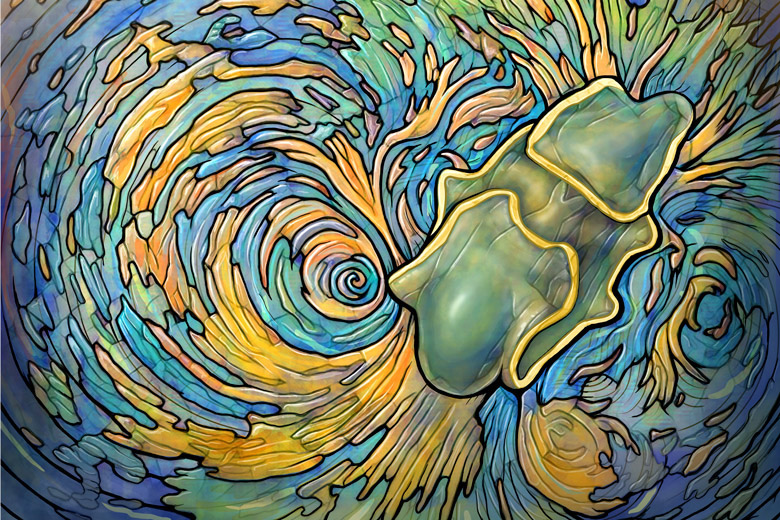Starfish larvae create complex water whorls to eat and run
Tiny starfish larvae employ a complex and previously unknown survival mechanism involving whorls of water that either bring food to them or speed them away to better feeding grounds.
Peek into a tide pool along the shore and you may see a starfish clinging quietly to a rock. But that secure adulthood comes at the expense of a harrowing larval journey. Tiny starfish larvae – each smaller than a grain of rice – spend 60 days and 60 nights paddling the open ocean, feeding to accumulate the energy needed to metamorphose into the familiar star shape.

A starfish larva is shown here to the right of a vortex of water. Stanford research reveals that starfish larvae evolved a mechanism that can either stir the water to bring food closer or propel the organism toward better feeding grounds. (Image credit: Rebecca Konte / Prakash Lab)
Along the way the larvae must make trade-offs between paddling in search of food and becoming exhausted by the journey. Now in a Nature Physics paper, a team led by Stanford bioengineer Manu Prakash has revealed the beautiful and efficient mechanism that allows these humble creatures to survive to adulthood. (See video here.)
“We have shown that nature equips these larvae to stir the water in such a way as to create vortices that serve two evolutionary purposes: moving the organisms along while simultaneously bringing food close enough to grab,” said Prakash, an assistant professor of bioengineering and recent MacArthur Foundation “genius” grant winner.
Using experimental techniques that capture the visual beauty and mathematical underpinnings of this mechanism, the researchers show how the shape and form of starfish larvae enable the functions that are necessary to support life.
“When we see strange and beautiful shapes in nature we bring them back to the lab and ask why they evolved this way,” Prakash said. “That is the perspective we bring to biology: to understand mathematically how physics shapes life.”
William Gilpin, first author on the paper and a graduate student in the Prakash Lab, said these findings shed light on similar evolutionary challenges involving dozens of marine invertebrates that are related to starfish larvae in a key way.
“Evolution seeks to satisfy basic constraints,” Gilpin said. “The first solution that works very often wins.”
Complex vortices
These experiments began in the summer of 2015 at Stanford’s Hopkins Marine Station in Pacific Grove, California. The researchers were taking a course on embryology when they began to wonder about the evolutionary underpinnings of the starfish larva’s shape—why did it end up looking as it did.
Bringing this curiosity back to the lab, the group studied the organisms in a systematic way, feeding the larvae nutrient algae and observing their movements with video-enabled microscopes.
“Our first eureka moment came when we saw the complex vortices flowing around these animals,” said Vivek Prakash (no relation), a postdoctoral scholar in bioengineering and third member of the team. “This was beautiful, unexpected and got all of us hooked. We wanted to find out how and why these animals made these complex flows.”
Gilpin said the vortices were puzzling because they seemed to make no evolutionary sense. It took a lot of energy to create spiral flows of water; thus a larva with just three imperatives – feed, move and grow – had to have a reason to expend such effort.
Orchestra of eyelashes
Once the researchers figured out how the larvae made the water swirl, that understanding led them to the why, and the experiment zeroed in on one of evolution’s most prevalent structures, the cilia, from the Latin word for eyelashes.
Imagine that the cilia on a starfish larva are like the oars that might be used to row an ancient galley – except that each larva has about 100,000 oars, arranged in what researchers call ciliary bands that gird the organism in a pattern far more complex than any galley’s oars.
The rowing metaphor hints at the complexity the researchers found as they studied how these 100,000 eyelashes paddled the larva through water.
Like oars, the cilia had three potential actions: forward, reverse and stop. And just as with oars, the cilia moved in different synchronized patterns to create different motions. Presumably orchestrated by its nervous system, the larva beats its 100,000 eyelashes in certain patterns when it wants to feed, so as to swirl the water in a way that brings algae close enough to grab. Then, with a different flutter of eyelashes, the larva creates a new pattern of whorls and speeds off.
The researchers realized that they were observing an active and previously unknown mechanism that improved the larva’s odds of survival. The physical structure of the starfish larva, controlled by its nerves, allows it to make feed-versus-speed tradeoffs – lingering whenever algae are plentiful, then darting off should nutrients grow scarce.
As they considered the implications of these findings, the researchers hypothesized that this feed-versus-speed mechanism likely applied to other invertebrate larvae that – though different than starfish larvae in form – are nonetheless known to have similar ciliary bands. In future experiments the Stanford researchers plan to use the same techniques to study these other larval shapes. What they hope to learn is how evolution has taken a certain mechanism, the ciliary band, and solved the same feed-versus-speed trade-off in dozens of different forms and shapes.
“That’s what we do in my lab,” Prakash said, “look for fundamental principles that we can express in equations to describe the beauty, diversity and functions of different forms of life.”
Prakash is also a member of Stanford Bio-X and Stanford ChEM-H and an affiliate of the Stanford Woods Institute for the Environment.
This work was supported in part by the U.S. Army Research Laboratory’s Multidisciplinary University Research Initiative and the National Science Foundation.
